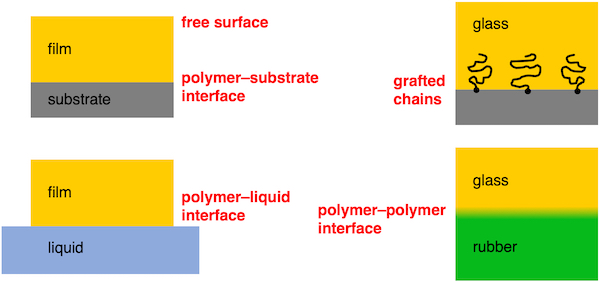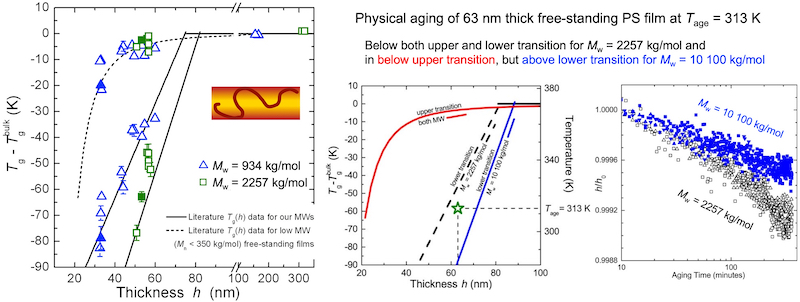The study of the glass transition in confined geometries is an active field of research in polymers, small molecules, colloids, and computer simulations. Confinement associated with decreasing system size (e.g. decreasing film thickness) is seen as a method of perturbing dynamic heterogeneity in glasses in order to gain insight into the length scales associated with cooperative motion. Polymer systems have been studied to the greatest extent because of the ease with which ultrathin films of known thickness can be made, and for their technological importance in applications such as microelectronics and gas separation membranes. Large shifts in the glass transition temperature Tg have been observed with decreasing film thickness for over two decades for film thicknesses less than ~100 nm, which are believed to be correlated to a host of other property changes. Interfaces dominate the behavior causing in large perturbing influences to the local structure and dynamics of the material as a function of distance from the interface. It is believed that similar mechanisms are behind the success of polymer nanocomposites.
Polymers Under Nanoconfinement: Where Are We Now in Understanding Local Property Changes?
Connie B. Roth,
Chemical Society Reviews 2021, 50, 8050-8066.
This review provides a summary of local glass transition temperature Tg changes near interfaces, comparing across different types of interfaces: free surface, substrate, liquid, and polymer–polymer. Local versus film-average properties in thin films are discussed, making connections to other related property changes, while highlighting several historically important studies. Emphasis is made to identify observations and open questions that have yet to be fully understood such as the evidence of long-ranged interfacial effects, finite domain size, interfacial breadth, and chain connectivity.

Refractive index and density changes in thin films
We have recently used ellipsometry to study how the refractive index (related to mass density) changes in thin films. By developing a linear gradient model for the refractive index with depth n(z), we have demonstrated that a gradient in refractive index emerges in thin polymer films for thicknesses less than ~50 nm, addressing recent reports of physically unrealistic density increases. Counter to common expectations of a simple free volume correlation between density and dynamics, we find that the direction of refractive index (density) gradient indicates a higher density near the free surface, which we rationalize as the enhanced dynamics near the free surface enabling more optimized denser molecular packings.

Gradient in Refractive Index Reveals Denser Near Free Surface Region in Thin Polymer Films
Yixuan Han and Connie B. Roth,
Journal of Chemical Physics 2021, 155, 144901.
Comparing Refractive Index and Density Changes with Decreasing Film Thickness in Thin Supported Films Across Different Polymers
Yixuan Han, Xinru Huang, Alan C. W. Rohrbach, and Connie B. Roth,
Journal of Chemical Physics 2020, 153, 044902.
Glass transition temperature Tg changes in ultrathin free-standing polystyrene films
Using transmission ellipsometry, we have measured the thermal expansion of ultrathin, high molecular weight (MW), free-standing polystyrene (PS) films over an extended temperature range. For two different MWs, we observed two distinct reduced glass transition temperatures (Tgs), separated by up to 60 K, within single films with thicknesses h less than 70 nm. The lower transition follows the previously seen MW dependent, linear Tg(h) behavior, while we also observed the presence of a much stronger upper transition that is MW independent and exhibits the same Tg(h) dependence as supported and low MW free-standing films. This represents the first experimental evidence indicating that two separate mechanisms can act simultaneously on thin free-standing polymer films to propagate enhanced mobility from the free surface into the material. The change in thermal expansion through the transitions indicate that ~90% of the film (matrix) solidifies at the upper transition with only ~10% of the material remaining mobile, freezing in at the lower transition. Surprisingly, when we compare our results to the existing literature, and especially the low MW free-standing film data, we conclude that the upper transition encompasses the free surface region and associated gradient in dynamics. This leaves open the question about where the small (~10%) fraction of material that has ultrafast, MW dependent dynamics resides within the film. Subsequent measurements demonstrated that physical aging occurs below this stronger upper transition, including above the MW-dependent lower transition, confirming that the majority of the film solidifies at the upper MW-independent transition.

Two Simultaneous Mechanisms Causing Glass Transition Temperature Reductions in High Molecular Weight Free-Standing Polymer Films as Measured by Transmission Ellipsometry
Justin E. Pye and Connie B. Roth,
Physical Review Letters 2011, 107, 235701.
Above, Below, and In-Between the Two Glass Transitions of Ultrathin Free-Standing Polystyrene Films: Thermal Expansion Coefficient and Physical Aging
Justin E. Pye and Connie B. Roth,
Journal of Polymer Science, Part B: Polymer Physics 2015, 53, 64-75.
Supported polystyrene films: Correlating physical aging and local Tg changes
We have observed changes in the physical aging for ultrathin supported polystyrene (PS) films that are correlated with the known local Tg reductions near a free surface. Using our streamlined ellipsometry method for characterizing physical aging, an aging rate β is determined from the time-dependent decrease in the film thickness as a function of the logarithmic aging time. We have measured the temperature dependence of the aging rate in ultrathin supported PS films and have found reduced physical aging rates at all temperatures for film thicknesses < 100 nm. Our analysis of these results have demonstrated that the physical aging rates in these ultrathin films are not simply shifted in correspondence with the average glass transition temperature Tg(h) reductions in these films, but that the reduced physical aging rates result from a gradient in enhanced dynamics present near the free surface of these films. The temperature dependence of the length scale characterizing the depth to which these enhanced dynamics penetrate into the film, from our analysis using a common two-layer model and a gradient model, are in very good agreement with similar length scales characterizing the gradient in Tg dynamics, strongly suggesting that these two phenomena are related. Subsequent measurements focused at an aging temperature of 40 °C demonstrated an unexpected molecular weight (MW) dependence to the physical aging rate of ultrathin 31 nm thick PS films not present in bulk films, where samples made from ultra-high MWs ≥ 6500 kg/mol exhibit on average a 45% faster aging response compared with equivalent films made from (merely) high MWs ≤ 3500 kg/mol. These results indicate the breadth of the gradient in dynamics originating from the free surface in these thin films is diminished for films of ultra-high MW PS. These results contribute to growing literature reports signaling that chain connectivity and entropy play a subtle, but important role in how glassy dynamics are propagated from interfaces.

Physical Aging in Ultrathin Polystyrene Films: Evidence of a Gradient in Dynamics at the Free Surface and Its Connection to the Glass Transition Temperature Reductions
Justin E. Pye, Kate A. Rohald, Elizabeth A. Baker, and Connie B. Roth,
Macromolecules 2010, 43, 8296-8303.
Unexpected Molecular Weight Dependence to the Physical Aging of Thin Polystyrene Films Present at Ultra-High Molecular Weights
Michael F. Thees and Connie B. Roth,
Journal of Polymer Science, Part B: Polymer Physics 2019, 57, 1224-1238.
